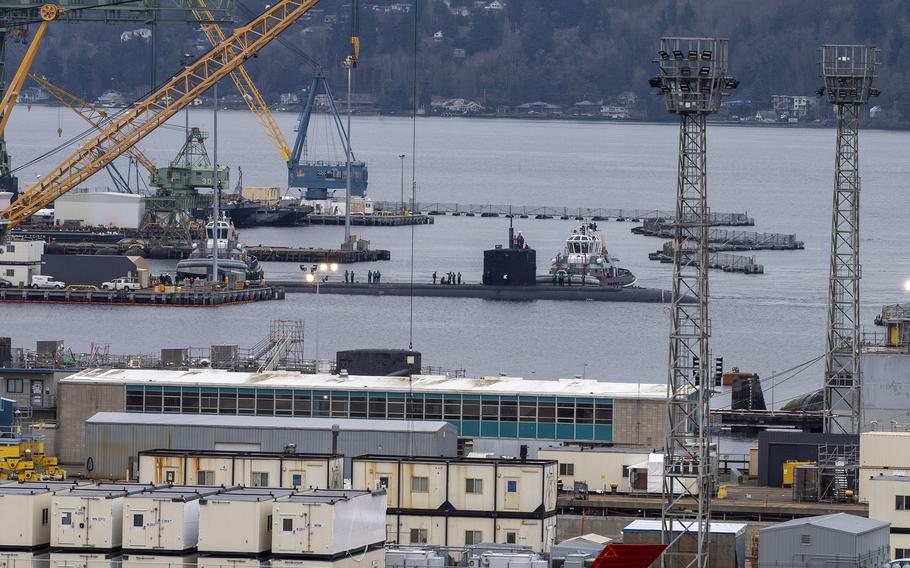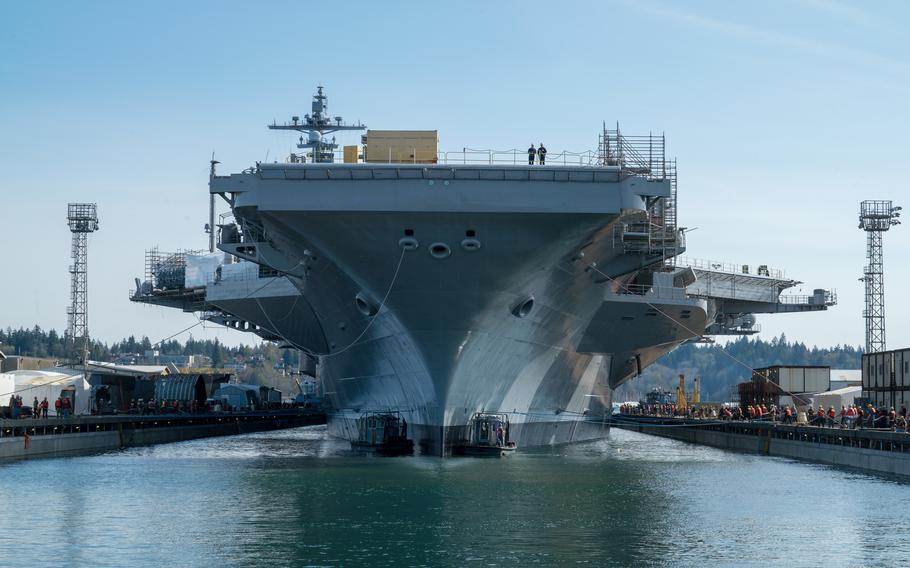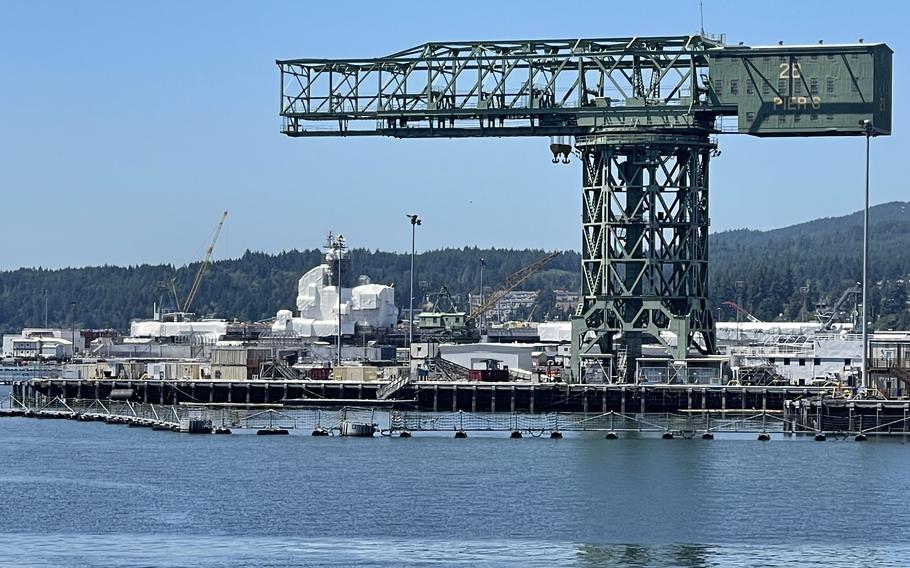
The Puget Sound Naval Shipyard is the Navy’s main maintenance and repair facility on the West Coast. (Joseph Paolucci/U.S. Navy)
BREMERTON, Wash. — The Navy plans to build a new dry dock at Puget Sound Naval Shipyard that can accommodate its largest aircraft carriers and nuclear-powered submarines into the 22nd century.
Details of the proposal were released Thursday evening during a briefing for the public at a community center in Bremerton near the waterfront.
Capt. John Hale, commanding officer of Naval Base Kitsap, which includes the shipyard, said the plan would help ensure the Navy remains a major presence in the Seattle area well into the next century.
“This is the only place on the West Coast that you can do maintenance on aircraft carriers,” he said. “The new dry dock maintains the capability here in the Pacific Northwest for the next 80 to 100 years.”
The shipyard has the only dry dock along the Pacific Ocean that can be used to repair Nimitz-class aircraft carriers and a variety of nuclear-powered submarines. But the new Gerald R. Ford-class carriers weigh enough to displace more than 100,000 tons of water and are just under 1,100 feet long.
David Gibson, a project manager for the Naval Facilities Engineering Systems Command, said the dry dock at Puget Sound Naval Shipyard was designed in the 1950s and built in the 1960s.
“Looking into the future, the Ford-class carriers will not fit in it,” he said. “You need to be able to have enough room at the back of the carrier to get the rudder off, get the shaft out, and get the prop off.”
The facility also needs triple the amount of electricity to maintain the operation of the modern-era reliance on computers aboard ships, and new developments such as airplane elevators and launching mechanisms operated by electromagnets instead of steam used for those jobs on current carriers.
The Navy now has only one shipyard in Norfolk, Va., that can handle the Ford-class carriers.

Aircraft carrier USS Carl Vinson in dry dock at Puget Sound Naval Shipyard in June 2020. (Ethan J. Soto/U.S. Navy)
A Ford-class carrier in Honolulu would need 22 days at a speed of 25 knots to travel the more than 13,000 miles to Norfolk, via Cape Horn at the southern tip of South America. The trip from Honolulu to Puget Sound at the same pace would cover 2,500 miles in four days.
Spread across 12,000 acres on a peninsula west of Seattle, Naval Base Kitsap has more than 15,000 sailors and other military personnel, along with more than 30,000 civilians, dependents and retirees.
“We operate and maintain aircraft carriers,” Hale said. “We have all three classes of submarines: fast-attack submarines, guided-missile submarines and ballistic-missile submarines.”
The Navy announced in May that Kitsap would be the homeport of the USS John F. Kennedy, the second Ford-class carrier, after it is commissioned next year.
Earlier this month, it issued a request for information to companies that could redevelop and lengthen a dock used by submarines at the Kitsap submarine base near Bangor.
The constellation of facilities along the west side of Puget Sound includes areas for developing undersea warfare technology and testing autonomous uncrewed vessels. The base is a major fuel depot, maintains torpedoes, and is the only base where retired nuclear-powered submarines can be dismantled and their reactors removed for preservation or disposal.
“The missions here are some of the most important missions that are required — in a part of the world, the Pacific, that is important to national defense,” Hale said.
The new dry dock at Puget Sound Naval Shipyard would also accommodate all sizes of active and proposed Navy ships, including Columbia-class, ballistic-missile submarines.
“So, we term it a multi-mission dry dock,” Gibson said. “It’s robust enough to handle any Navy mission.”
The first of the new class, the USS District of Columbia, is now expected to join the fleet in late 2028. Armed with ballistic missiles, it’s expected to replace the late Cold War-era USS Ohio class of ballistic-missile submarines.
The Navy recently began work on electric upgrades at a pier at Bremerton to upgrade its power supply to support the John F. Kennedy when it arrives in two to three years.
Plans for improving and lengthening a pier at the submarine area at Bangor for Columbia-class submarines and the new Virginia-class submarines were circulated late last month.
The Navy presentation on Thursday officially listed three alternatives. Alternative 1 would essentially do nothing — keeping facilities as they are and not building a new dry dock. Alternative 3 would see significantly less construction and renovation but allow for modernization of existing facilities.
The Navy’s preferred plan — Alternative 2 — would demolish or replace piers, wharves, moorings, cranes, buildings and other facilities at the shipyard. It would build the new dry dock east of the current one and construct “seismically resilient” structures that could survive a major earthquake intact.
The cost of the preferred alternative has not been publicly disclosed. The Navy has reported spending nearly $50 million on the design work alone.
The project faces hurdles. Environmental issues such as the release of fuels, chemicals and solvents into Puget Sound have dogged the shipyard for years. The shipyard is listed as a Superfund site by the Environmental Protection Agency. The draft statement also includes moving aircraft carrier maintenance to a more eastern portion of the shipyard that would increase noise in nearby neighborhoods.
Shipyard backers in Congress have questioned whether the shipyard can attract enough qualified workers to make the new dry dock a feasible operation. Congress is considering bipartisan legislation to exempt welders and other key shipyard workers from workforce cuts pushed by President Donald Trump’s administration under the task force set up by billionaire Elon Musk called the Department of Government Efficiency, or DOGE.
The more than 1,200 jobs that the project is expected to create would generate more than $76 million for the local economy. But locals would experience additional traffic and competition for parking and housing, the report said.
The Navy’s preferred plan would also lead to changes in an area covered by the National Historic Preservation Act, which requires consultation with local authorities, preservation advocates and representatives of tribal and other stakeholder groups.
The restored World War II-era workshop near the Bremerton Ferry building would have to be moved or demolished.
The soaring hammerhead crane — once used to lift finished World War II gun turrets onto the decks of battleships — would also be in the way of the project. The crane has been called the “Eiffel Tower of Puget Sound” because of its steel latticework. It would be demolished or moved to another location.

Hammerhead Crane at Puget Sound Naval Shipyard in May 2025. (Gary Warner, Stars and Stripes)
Hale, the base commander, said Kitsap would continue to homeport at least one aircraft carrier and carry on its maintenance missions throughout the dry dock project, which could take 12 years to complete.
“There’s activity that happens here today that will have to move, people work in those areas who will have to be relocated,” he said. “We can’t stop doing the work for 12 years. We’ll have to work around it.”
The Navy is asking for public comment on the “alternatives” through Sept. 3. A final decision on whether to move ahead with the preferred construction plan would officially come in summer 2026.
Hale said the project would ensure the Puget Sound area would remain a key Navy operations center as it has since the late 19th century.
“This demonstrates the commitment that the Navy has to the Pacific Northwest,” he said. “The most important missions that the Navy does are done here.”